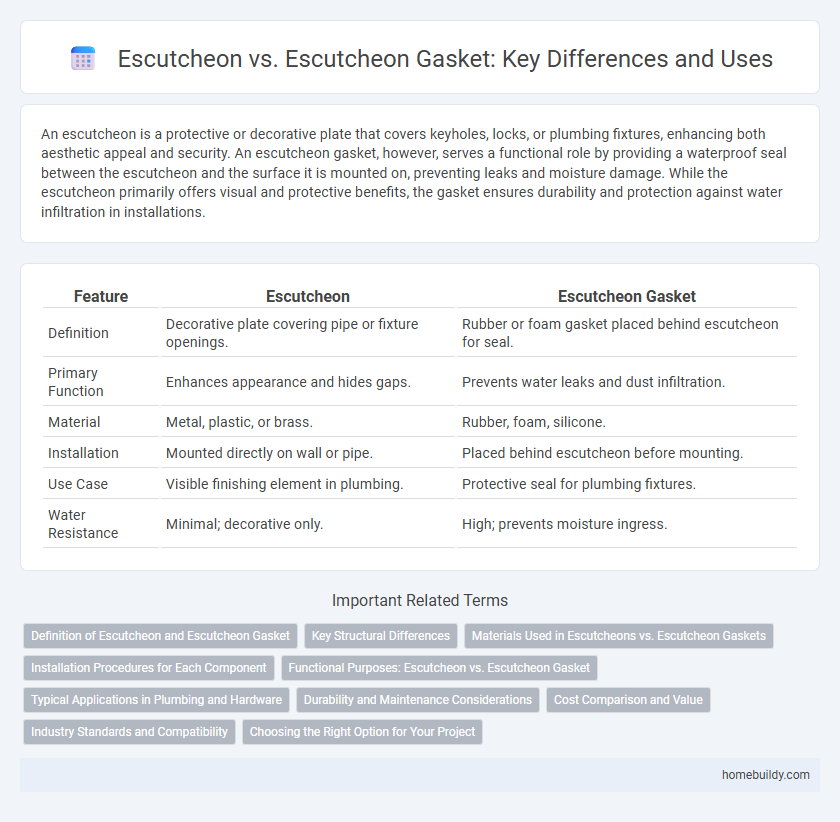An escutcheon is a protective or decorative plate that covers keyholes, locks, or plumbing fixtures, enhancing both aesthetic appeal and security. An escutcheon gasket, however, serves a functional role by providing a waterproof seal between the escutcheon and the surface it is mounted on, preventing leaks and moisture damage. While the escutcheon primarily offers visual and protective benefits, the gasket ensures durability and protection against water infiltration in installations.
Table of Comparison
| Feature | Escutcheon | Escutcheon Gasket |
|---|---|---|
| Definition | Decorative plate covering pipe or fixture openings. | Rubber or foam gasket placed behind escutcheon for seal. |
| Primary Function | Enhances appearance and hides gaps. | Prevents water leaks and dust infiltration. |
| Material | Metal, plastic, or brass. | Rubber, foam, silicone. |
| Installation | Mounted directly on wall or pipe. | Placed behind escutcheon before mounting. |
| Use Case | Visible finishing element in plumbing. | Protective seal for plumbing fixtures. |
| Water Resistance | Minimal; decorative only. | High; prevents moisture ingress. |
Definition of Escutcheon and Escutcheon Gasket
An escutcheon is a protective or decorative plate that covers the hole where a pipe or fixture passes through a surface, enhancing appearance and preventing debris or pests from entering. An escutcheon gasket is a specialized sealing component placed between the escutcheon and the wall or fixture to ensure a watertight and airtight fit, preventing leaks and moisture damage. While the escutcheon serves an aesthetic and protective function, the escutcheon gasket focuses on creating a secure seal to maintain system integrity.
Key Structural Differences
Escutcheons are decorative or protective plates that cover and reinforce openings around pipes or fixtures, typically made of metal or plastic, while escutcheon gaskets integrate a sealing element to prevent water leakage and provide a watertight barrier. The key structural difference lies in the gasket's flexible, compressible material, usually rubber or silicone, which fits between the escutcheon and the surface, ensuring a tight seal. Escutheons alone offer aesthetic and protective functions but lack the sealing capabilities essential in plumbing applications where moisture resistance is critical.
Materials Used in Escutcheons vs. Escutcheon Gaskets
Escutcheons are typically crafted from durable metals such as brass, stainless steel, or chrome-plated zinc, chosen for their aesthetic appeal and corrosion resistance in plumbing and hardware applications. In contrast, escutcheon gaskets are usually made from flexible materials like rubber, silicone, or neoprene to provide a watertight seal between the escutcheon plate and the surface it covers. The combination of rigid escutcheon materials with pliable gasket components ensures both structural support and effective protection against leaks or moisture intrusion.
Installation Procedures for Each Component
Escutcheon installation involves securing the decorative plate around plumbing fixtures, ensuring alignment with wall or sink surfaces, typically using mounting screws or adhesive pads. In contrast, installing an escutcheon gasket focuses on placing the flexible rubber or silicone seal between the escutcheon and the fixture or wall to create a watertight barrier, often requiring careful compression and positioning to avoid leaks. Proper installation of both components requires attention to surface cleanliness and alignment to maintain aesthetic appeal and prevent water damage.
Functional Purposes: Escutcheon vs. Escutcheon Gasket
An escutcheon primarily serves a decorative and protective role by covering plumbing holes and preventing water damage on walls or surfaces. In contrast, an escutcheon gasket provides a functional seal between the escutcheon and the pipe, preventing water leaks and ensuring a secure fit. Together, they enhance both the aesthetic appeal and waterproof integrity of plumbing installations.
Typical Applications in Plumbing and Hardware
Escutcheons are decorative and protective plates commonly used in plumbing and hardware to cover pipe penetrations and mounting holes, ensuring a clean and finished appearance around faucets, showerheads, and valve stems. Escutcheon gaskets, made of rubber or foam, provide a watertight seal between the escutcheon and the mounting surface, preventing water leakage and corrosion in plumbing installations. Typical applications include bathroom and kitchen fixtures, where both escutcheons and escutcheon gaskets contribute to durability, aesthetics, and moisture protection.
Durability and Maintenance Considerations
Escutcheons provide a durable protective cover for plumbing fixtures but are typically made from metal, which resists corrosion and wear, requiring minimal maintenance. Escutcheon gaskets, made from rubber or silicone, offer additional sealing against leaks and moisture infiltration, enhancing durability in wet environments but may require periodic replacement as they degrade over time. Regular inspection of escutcheon gaskets is essential to maintain an effective seal and prevent water damage, whereas metal escutcheons often only need occasional cleaning to retain their appearance.
Cost Comparison and Value
Escutcheons typically cost less initially compared to escutcheon gaskets, making them a budget-friendly option for decorative coverage around pipes and fixtures. Escutcheon gaskets, while slightly more expensive, provide enhanced sealing and protection against leaks, offering greater long-term value by preventing costly water damage and maintenance. Choosing between the two hinges on balancing upfront cost savings with the potential for increased durability and protection.
Industry Standards and Compatibility
Escutcheons and escutcheon gaskets play distinct roles in plumbing and door hardware, with escutcheons providing decorative and protective finishes around fixtures, while escutcheon gaskets ensure watertight seals preventing leaks. Industry standards such as ANSI A112.18.1 and ASTM F436 define material quality, dimensions, and compatibility requirements, ensuring uniformity across manufacturers. Compatibility between escutcheons and gaskets is critical, as mismatched components can cause sealing failures or corrosion, emphasizing adherence to specified tolerances and material grades for optimal performance.
Choosing the Right Option for Your Project
Selecting the right escutcheon or escutcheon gasket depends on the specific requirements of your plumbing or hardware project. Escutcheons provide a decorative cover for pipe entries and fixture bases, enhancing aesthetics and concealing rough wall openings. In contrast, escutcheon gaskets offer a watertight seal beneath the escutcheon plate, preventing leaks and ensuring a secure fit, making them essential for moisture-prone environments.
escutcheon vs escutcheon gasket Infographic

 homebuildy.com
homebuildy.com